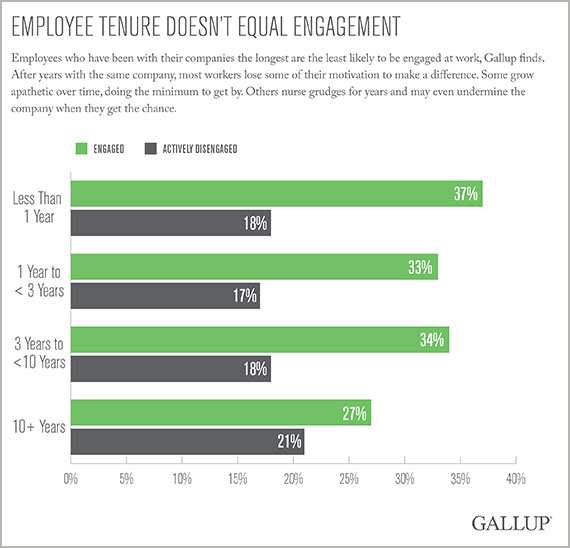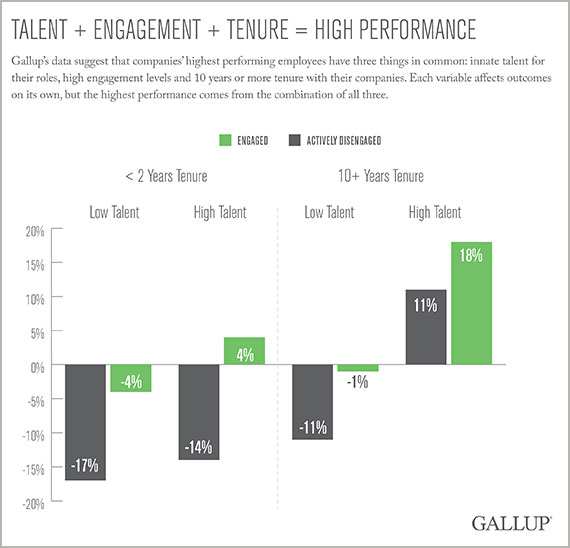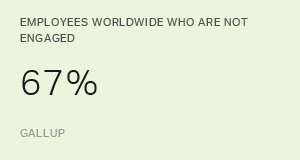Story Highlights
- The longest tenured are also the least likely to be engaged
- Three key attributes to performance exist in only 5% of workers
- Companies must align talent, engagement and tenure strategies
Let this be a wake-up call for business leaders: Employees with the longest tenures in your company are also the least likely to be engaged.
After years with the same company, most workers lose some of their motivation to make a difference. Many grow apathetic over time and spend each day doing the minimum to get by. Some nurse grudges for years and even undermine the company when they get the chance.

It's tempting to say these employees' low engagement levels are their own problem, when it's actually the company's problem. Retaining long-tenured, highly capable employees is a challenge. However, minimizing turnover is more practical than churning through new hires who, even after costly training, might or might not turn out to be a fit for the complex requirements of a role.
Companies and products in today's knowledge-based economy are increasingly specialized, so experience counts for a lot. By turning the tables on the typical inverse relationship between tenure and engagement, companies stand to make dramatic performance gains.
The Highest Performers Have Three Things Going for Them
Gallup's data suggest that companies' highest performing individuals have three things going for them: (1) they have tenures of a decade or more in their organizations; (2) they are in their work; and (3) they are in roles where the expectations of the job align well their . Each variable affects outcomes on its own, but the highest performance comes from the combination.
But here's the unfortunate fact: In the typical company among the hundreds we've studied, this combination exists in just 5% of individual contributors.

Tenure matters because having years of experience with a company yields deep organizational expertise. Those years cultivate a nuanced understanding of how a company operates and how to maneuver through organizational channels and get things done with minimal friction. Through countless hours of collaboration with the same coworkers and teams, veteran employees gain tacit knowledge that allows them to predict how colleagues will behave and anticipate how they will respond to everyday situations. This sort of in-depth knowledge is immensely useful to employers, but prospective employees can't obtain it in business school or replicate it by working in a similar company or role.
Indeed, numerous academic studies have found that individuals with longer organizational tenures tend to achieve higher performance levels. Their improvement trajectory, likely a mix of their growing capabilities and the increasing importance of the jobs they hold, might become less steep over time, yet it continues upward year after year. Experience so strongly influences performance that it allows long-tenured employees to outperform the average despite being less engaged than their colleagues are. Still, counting on tenure alone to deliver competitive levels of performance would be folly.
Getting to Do What They Do Best
Engagement also makes a big difference. 优蜜传媒found that this is true after working with to increase their employees' engagement. The effect is pronounced even in employees with less than two years' tenure -- perhaps because higher engagement makes them more likely to interpret and use their early experiences productively. Engagement's effect on performance continues throughout the employee life cycle to employees of long-term tenures -- 10 years or more.
What can do to increase engagement? Gallup's research shows that employees are most likely to be engaged -- and stay with their companies -- when they report that their managers understand them and give them the chance to do what they do best every day. Managers can help employees find ways to do more of what they're good at.
This brings us to the importance of innate talent and matching people well with roles. Success starts with hiring employees with the right talents for jobs in the first place -- or failing that, being quick to reposition them in jobs that fit them better. People's innate talents matter a great deal to how well they do their jobs. Our research shows that of tenure, engagement and talent, talent is the strongest predictor of performance.
Further, our analysis shows that talented employees with longer tenures can achieve above-average performance even in work environments that are not very engaging. Alternatively, talented and engaged employees can achieve above-average performance even with less than two years of tenure. The effect of talent is only minimized to below-average performance when a talented person has less than 10 years of tenure and is actively disengaged at work.
To understand the combined effect of tenure, engagement and talent on performance, my colleagues and I launched a large-scale study. It included recent data from 20 studies across seven organizations and more than 7,000 individual contributors in various roles, including customer service, call centers, financial consultants, sales representatives, nurses, support staff and clinical staff.
Our finding that just 5% of employees are in the proverbial "sweet spot" -- engaged at work, in roles that are the right fit for them and at their company for 10 years or more -- likely indicates that few organizations are examining their workforce to understand where their people fit in this configuration. Yet our results suggest there's much more these organizations can gain from getting employees in the sweet spot.
Hitting the Trifecta of Tenure, Engagement and Talent
Employees who hit the trifecta of tenure, engagement, and talent perform 18% higher than the average employee and 35% higher than a worker who goes zero for three. For skilled production and support staff, this equates to a financial outcome of $6 million and $12 million, respectively, per 1,000 employees. For highly educated professionals, the economic outcome essentially doubles from $12 million to $23 million per 1,000 workers.
In many companies, it may seem unrealistic to have a surplus of workers with 10 or more years of tenure. Even among workers who have less tenure and are engaged and highly talented for their role, their performance is 9% better than average and 24% higher than someone with low talent who is actively disengaged.
The most important thing that companies must do to get the most from their workforce is to align their talent, engagement and tenure strategies. Using scientific predictive analytics to hire people with the right talents for their role gives them a better shot at becoming engaged because they have more opportunity to do what they do best. And pairing talented employees with great managers helps to boost and sustain engagement, increasing the likelihood of retention. This leads to a longer, more meaningful tenure for employees and, ultimately, a more productive and valuable workforce poised to support high organizational performance.
While the three parts of the configuration inherently support one another, few organizations are combining their selection, engagement and retention initiatives in a strategic way.
A version of this article originally appeared on the .
Sangeeta Agrawal, Ben Wigert and Yongwei Yang contributed to the research in this article.
Methods
The employee engagement and tenure analysis is based on responses from 7,688 employed adults, aged 18 and older, in 2014, collected via Gallup's nationally representative probability-based panel of U.S. households. Engagement percentages are based on responses to Gallup's Q12 employee engagement metric with established meta-analytic links to various important business and well-being outcomes. 优蜜传媒researchers conducted a meta-analysis of links among organizational tenure, employee engagement and talent to establish the additive effect findings based on data collected in 20 research studies, in seven different organizations and among 7,477 employees. Job types included customer service, call center, financial consultants, sales representatives, nurses, support staff and clinical staff. Gallup's talent selection database, built over four decades, includes 12,000 items gathered from more than 500 organizations in 50 countries and 20 industries. Our employee engagement database contains data from more than 3.1 million teams and 27 million employees.

